
by Cora Buhlert
The biggest phenomenon in West German cinemas in the past five years is none other than Edgar Wallace, Britain's king of thrillers.
The enduring popularity of Edgar Wallace in Germany may seem baffling, since Wallace died in 1932 and most of his thrillers were written in the 1910s and 1920s. American readers will probably best remember Wallace as the creator of King Kong and screenwriter of the eponymous movie.

Edgar Wallace
However, Germans have long loved Edgar Wallace, which is odd, since Edgar Wallace did not particularly like Germany, as many of his writings show. Nonetheless, his thrillers were hugely popular in Germany in the 1920s and early 1930s, until the Nazis banned them along with the entire crime genre as "too subversive". In the 1950s, paperback publisher Goldmann started reissuing the Edgar Wallace thrillers to great success. And as always when something is successful, others took note. One of them was "Heftroman" publisher Pabel, whose Utopia Kriminal line of science fiction thrillers was directly inspired by the popularity of the Edgar Wallace novels.
German film producers also took note and indeed there were a few German Edgar Wallace adaptations during the silent and early talkie era. However, plans to adapt Edgar Wallace novels in 1950s repeatedly failed, because crime and thriller movies supposedly did not sell in postwar West Germany, since viewers allegedly demanded harmless musicals and romances set in beautiful landscapes rather than tales of crime and murder. In 1959, Danish film producer Preben Philipsen took a chance and adapted the Edgar Wallace novel The Fellowship of the Frog for German audiences. The result was a huge success and led to a wave of more or less faithful Edgar Wallace adaptations (nineteen to date) and copycats that show no sign of abating.
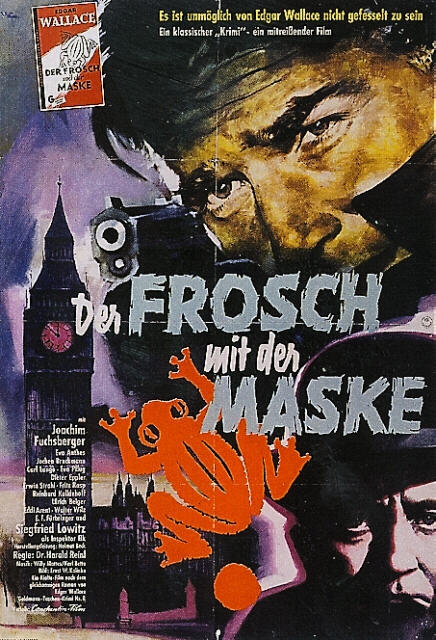
Poster for Face of the Frog (1959)
The Edgar Wallace movies are primarily crime thrillers, though there is nothing remotely realistic about them. Instead, the films are set in a fog-drenched England and particularly London that never was, full of dodgy harbour bars where nefarious crimes are plotted as curvy sirens sing torch songs, where the River Thames is used a convenient corpse disposal and where Scotland Yard is headed by a dim-witted gentleman named Sir John (played by Siegfried Schürenberg who serves as a sort of link between the various movies) with a taste for buxom secretaries. Inspectors are handsome and dashing, played by either Heinz Drache or Joachim Fuchsberger, unless they are played by the plump and balding Siegfried Lowitz, in which case he has a dashing Sergeant. There is always a comic relief character, often a bumbling butler, who is usually played by Eddi Arent.

Joachim Fuchsberger, Siegfried Schürenberg and Eddi Arent in The Squeaker (1963)
Women in Edgar Wallace movies come in three flavours, mysterious elderly ladies, usually played by veteran UfA actresses, who may or may not be involved in the villain's machinations, buxom femme fatales who are involved with the villain and often end up paying the ultimate price for their villainous ways (Eva Pflug in Face of the Frog was the best of them) and finally, young and pretty damsels in distress (often played by Karin Dor), who find themselves pursued and often kidnapped by the villain, before they are rescued and end up marrying the dashing Inspector.

Eva Pflug being admired by Jochen Brockmann in Face of the Frog (1959)
Occasionally, the Wallace movies manage to subvert expectations. And so the dashing detective is unmasked as the killer in The Red Circle (1960), while the wide-eyed ingenue is revealed to be the showgirl slashing killer in this year's Room 13.
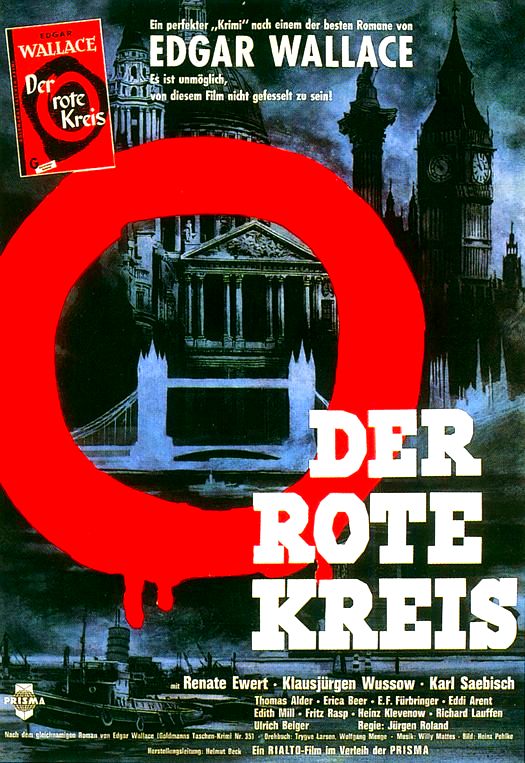
Poster for The Red Circle
Wallace villains are never just ordinary criminals, but run improbably large and secretive organisations with dozens of henchmen. At least one of the henchmen is deformed or flat out insane, played either by former wrestler Ady Berber or a charismatic young actor named Klaus Kinski, who gave the performance of his life as a mute and insane animal handler in last year's The Squeaker.
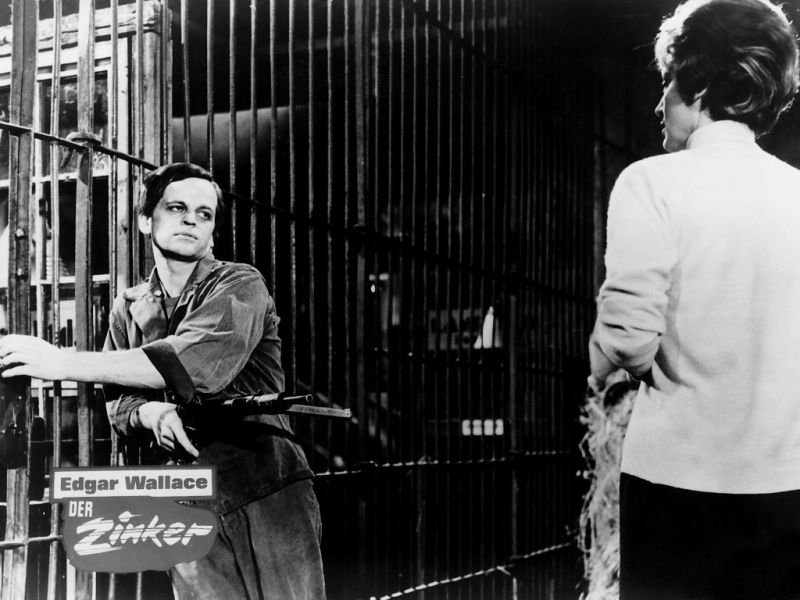
Klaus Kinski threatening Inge Langen in The Squeaker
The crimes are extremely convoluted, usually involve robberies, blackmail or inheritance schemes and are always motivated by greed. Murder methods are never ordinary and victims are dispatched via harpoons, poison blow guns, guillotines or wild animals. The villains inevitably have strange monikers such as the Frog, the Shark, the Squeaker, the Avenger, the Green Archer or the Black Abbot and often wear a costume to match. Their identity is always a mystery and pretty much every character comes under suspicion until the big reveal at the end. And once the mask comes off, the villain is inevitably revealed to be a staunch pillar of society and often a member of Sir John's club.
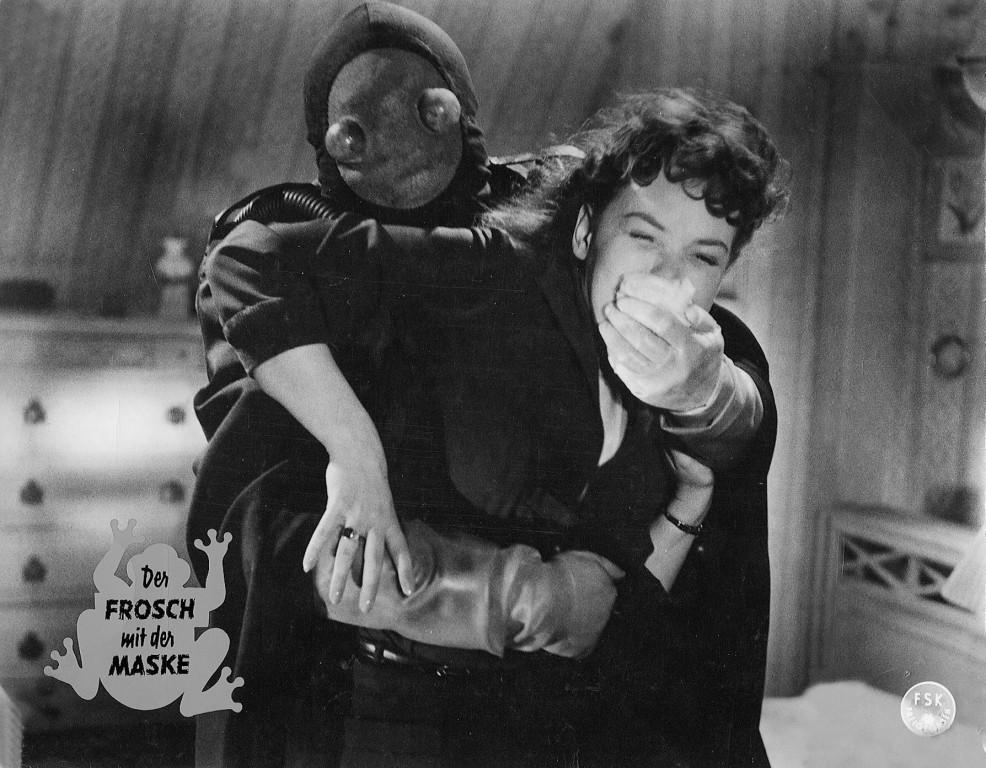
The Frog kidnapping Eva Anthes in Face of the Frog (1959)
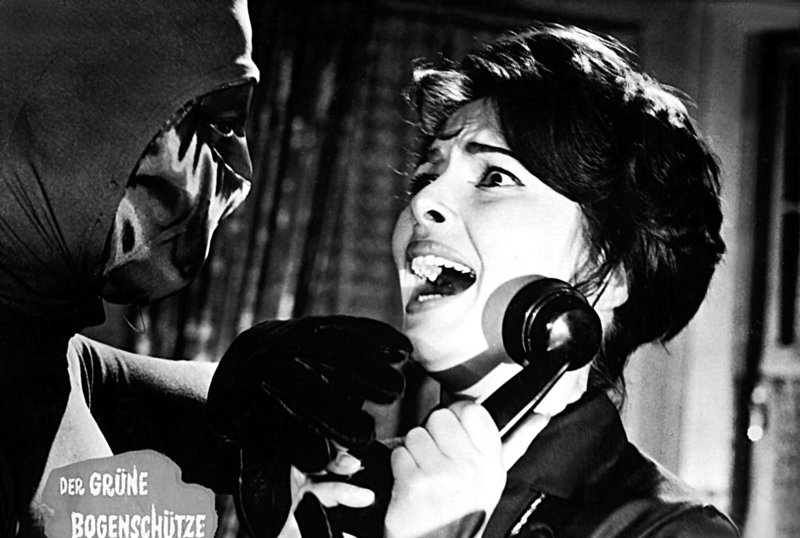
The Green Archer terrifies Karin Dor in The Green Archer (1961)

Eddi Arent attempts to apprehend the the Black Abbot in the eponymous film (1963)
The Edgar Wallace films are cheaply made, with Hamburg or Berlin standing in for London and German castles standing in for British mansions. Nonetheless, they have a unique visual flair, courtesy of directors Harald Reinl, Jürgen Roland and Alfred Vohrer. All films are shot in stylish black and white, using the widescreen Ultrascope process. Contrasts of light and shadow are used to great effect, such as the shadow of a dangling noose falling onto a stark white prison wall in Face of the Frog. Strange camera angles are common and scenes are shot through the eyes of an unseen killer, through the dial of a rotary telephone and in one memorable case, though the mouth of Sir John chomping on a carrot. The highly stylised look of the Edgar Wallace films is uncommon in contemporary German cinema. Instead, the Edgar Wallace films take their visual inspiration from the expressionist cinema of the 1920s and early 1930s, returning German filmmaking to where it was before the Nazis took over.
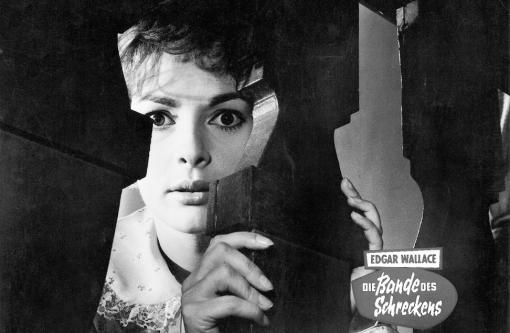
Karin Dor spies on The Terrible People (1960)
Are the Edgar Wallace films science fiction? Well, they are mainly crime thrillers, though they also include horror elements and take visual inspiration from the German horror cinema of more than thirty years ago. The Dead Eyes of London from 1961 is probably the closest the Wallace series has come to pure horror to date, largely due to the performance of Ady Berber as the blind and supernaturally strong killer Jack.

Program book for The Dead Eyes of London, featuring Ady Berber threatening Karin Baal
Science fiction elements also frequently appear in the Edgar Wallace movies, often in the form of death traps and complicated murder methods. The Green Archer (1961) uses the old standby of the underground chamber (in which the villain, played by the excellent Gert Fröbe, has kept the lover who spurned him imprisoned for decades) that slowly fills with water. The Strange Countess (1961) features a deadly electrified grid, which protects the jewels the titular villainess has stolen. The Countess, played with chilling haughtiness by silent era veteran Lil Dagover, is eventually electrocuted by her own death trap. Meanwhile, in The Dead Eyes of London, a domed glass tank in the basement of a church-run home for the blind is used to drown wealthy men before their bodies are thrown into the Thames, allowing the villainous Dead Eye gang to claim their life insurance. And in The Squeaker, the titular villain dispatches his opponents via a blow gun shooting crystals of snake venom. As mentioned above, the criminal plots and murder methods in the Wallace are always convoluted and often don't make a whole lot of sense. But that doesn't matter, because you're usually much too captivated by the going-ons on screen to worry about such little matters as logic.
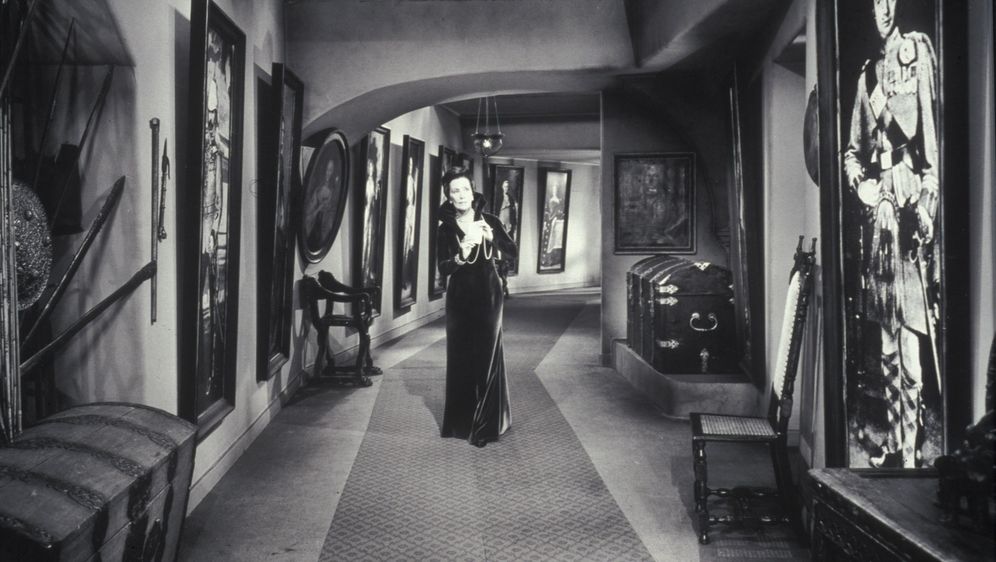
Lil Dagover prowls her castle in The Strange Countess (1961)
The 1962 film The Door With Seven Locks even features a bona fide mad scientist, played by Wallace film regular Pinkas Braun, who conducts medical experiments such as brain transplants in a hidden vault underneath a country mansion. This makes the otherwise not particularly remarkable The Door With Seven Locks the most science fictional Edgar Wallace film to date.

Poster for The Door with the Seven Locks (1962)
Critics don't like the Edgar Wallace films, complaining about the lack of realism, the alleged predictability, the lurid and sensational nature of the crimes portrayed and the (by West German standards) high levels of violence. Those critics have a point, for the Edgar Wallace films are lurid and sensational, violent and completely unrealistic. However, the sheer artificiality is why I enjoy these movies so much and why I inevitably head for the neighbourhood movie theatre whenever a new Edgar Wallace movie premieres (and we currently get several of them every year). Even the lesser entries of the series are well worth watching and the standouts such as Face of the Frog, The Green Archer, The Dead Eyes of London, The Inn on the River, The Squeaker or The Indian Scarf provide excellent chills and thrills.
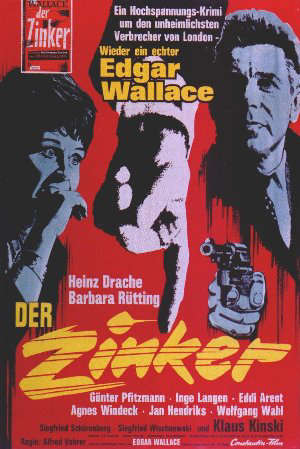
Poster for The Squeaker (1963) )
As for those who claim that the Edgar Wallace movies have nothing to do with real life, well, they're mistaken, for the Wallace films do reflect contemporary West German concerns, though through the distorted lens of a funhouse mirror. The fact that the motive for the bizarre crimes on screen is always greed reflects concerns about the rampant materialism in postwar West Germany. Just as the fact that the villain is inevitably revealed to be an upstanding pillar of society under his (or more rarely her) mask is all too reminiscent of recent revelations that quite a few politicians, judges, doctors, professors, civil servants and captains of industry used to be Nazis and still somehow managed to continue their careers unimpeded in postwar West Germany. As for the tendency of henchmen in Wallace movies to mutter, "But I was just following orders. You can't blame me", when captured – well, where have we heard that before?

Poster for The Terrible People (1960)
The Edgar Wallace movies offer pleasantly comforting shudders, as the viewer delves into a strange parallel world, where London is the murder capital of Europe and the Squeaker, the Frog, the Black Abbot and the rest of the Wallace menagerie stalk the fog-shrouded streets to commit bizarre crimes. And even though all movies stand alone, they are set in the same universe with Siegfried Schürenberg's Sir John acting as a link between the different stories. This shared universe concept occasionally shows up in literature such as the Cthulhu mythos, but has never really been tried in movies so far. The possibilities are limitless.

Sir John (Siegfried Schürenberg) is shocked that the latest villain turns out to be yet another member of his club.
The success of the Edgar Wallace movies quickly spawned a host of imitators. Producer Artur Brauner acquired the rights to several crime novels by Bryan Edgar Wallace, son of Edgar Wallace, while Constantin Film adapted several novels by Czech writer and Edgar Wallace imitator Louis Weinert-Wilton. Other imitations are more of a stretch, such as a series of Wallace style movies featuring G.K. Chesterton's Father Brown.
However, the most interesting of the many crime thrillers released in the wake of the Edgar Wallace movies are the Dr. Mabuse movies produced by Artur Brauner. Based on a supervillain character created by Norbert Jacques in the 1920s, they are not just unambiguously science fiction, but also a return to the glory days of German cinema during the Weimar Republic. But that's a subject for another day.
[Come join us at Portal 55, Galactic Journey's real-time lounge! Talk about your favorite SFF, chat with the Traveler and co., relax, sit a spell…]

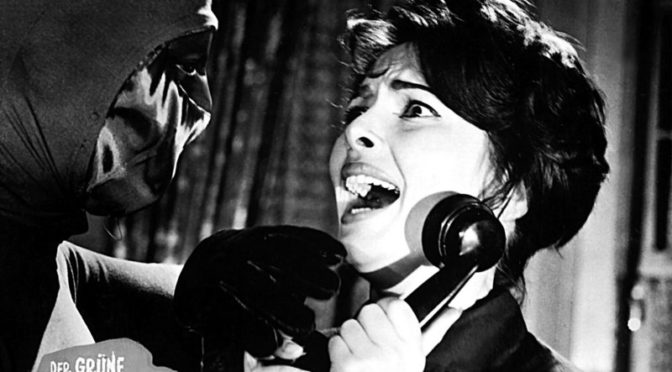

These films really are a great deal of fun. Perfect for just turning off your brain and enjoying some popcorn (well, if Germans didn't insist on popcorn being sweet). Wallace's stories are pretty standard adventure stories of the teens and twenties. Think Fu Manchu without the Yellow Peril.
Good eye spotting the influence of German Expressionism in these films. It's astonishing to see what German cinema was producing in the 20s, while Hollywood was churning out Tom Mix, Keystone Kops and Busby Berkeley nonsense. I think the only thing I would add to your description is that there's often a very Gothic sensibility to the stories as well. Maybe it's just all the fog and manor houses.
I definitely prefer Blacky Fuchsberger as the hero and could probably do with a little less Eddi Arendt, but that Kinski fellow really stands out among the bad guys. I'd say he'll wind up typecast and forgotten once these films go out of fashion, but he did a pretty good turn as a Jewish refugee in The Counterfeit Traitor with William Holden, played a Scotland Yard inspector in a Dr. Mabuse film last year, and I hear he's in the new Winnetou film they're working on. Maybe he'll amount to something after all.
Your local neighbourhood cinema serves popcorn? Mine only serves Langnese Eiskonfekt. Not that it isn't nice on a hot day like today.
I agree that there is a definite gothic sensibility to some of the Edgar Wallace films, particularly the ones featuring fog-shrouded castles. And the Black Abbot is a pure gothic villain, a mad monk in the tradition of Matthew Lewis.
Eddi Arendt is a fine actor, but his comic relief characters can grate on occasion. I wish they would cast him against type for once, like they did with Karin Dor in "Room 13" earlier this year or Klausjürgen Wussow in "The Red Circle" or Günther Pfitzmann in "The Squeaker".
As for Klaus Kinski, he's obviously very talented and I'd hate to see him typecast. Though he did play an undercover police officer in "The Inn on the River" a few years ago.
I hear that they're currently filming "The Ringer", which will apparently be the biggest Wallace film yet. Though it's impossible to learn much about the movie, because the production is shrouded in secrecy.
Great article, loved reading every part of it. I have never heard of this series until now. However, I have heard of Dr. Mubase and seen one movie of the series. The one in which he has the means to turn invisible.
You mean "The Invisible Claws of Dr. Mabuse". That's a good one and definitely science fiction.
We're supposed to get another Dr. Mabuse movie later this year, so that's something to look forward to. Even if last year's Mabuse film was somewhat lackluster.
Yes, I think that was the name of it unless it was under a variant title. It was a good movie as well. Maybe I will get to see another sometime soon.
I love the final scene of "The Invisible Claws of Doctor Mabuse" where the police fights against Mabuse's invisble army. Some very good special effects in that one.
Yes, I remember the conclusion being very exciting. A very good story overall.
Some of these things must have turned up already on American television, badly dubbed and no doubt edited a bit for sensitive viewers, as I can recall seeing a few. The identity of the villain seems to be decided with the flip of a coin, but, as said, you don't watch these for plot logic.
Maybe I'm just thinking of the British film "The Dark Eyes of London" (1939) with Bela Lugosi, which is, obviously, based on the same story as "The Dead Eyes of London." (Here in the states, they call the old version "The Human Monster" and show it on Shock Theater.)
The Dr. Mabuse films must be broadcast here in the States from time to time as well. Of course, there's the original silent classic, and its talkie sequel, which show up at arty movie theaters now and then, but I seem to recall seeing "The Thousand Eyes of Dr. Mabuse" on TV, with all those hidden cameras watching everybody all the time. Creepy.
The Edgar Wallace movies can get quite violent on occasion with people strangled, shot or drowned in close-up. Most of them have a 16 or 18 certificate in Germany, so I'm not surprised if they're edited for a TV broadcast. The same thing will probably happen here, if they ever show up on TV (maybe in 20 years).
I know that there are British Edgar Wallace adpations, though I've never seen one. But Bela Lugosi in "The Dark/Dead Eyes of London" sounds interesting. Which role does he play, the blind killer or the criminal mastermind behind the crimes.
Regarding the Dr. Mabuse, the current film series is actually a direct sequel to the two Mabuse movies from the Weimar Republic. Since Mabuse's original body died in the second film, he is a malevolent spirit and can hop from body to body. Kommissar Lohmann, the police inspector who hunted Dr. Mabuse in the 1933 "The Testament of Dr. Mabuse" (and who also hunted the killer in Fritz Lang's M) also reappears in the new movie, though played by a different actor (Gert Fröbe who has since defected to make the next Bond film). "The Thousand Eyes of Dr. Mabuse" is the first of the postwar Mabuse movies. It's very creepy and was directed by Fritz Lang, who had also directed the two earlier movies. He's departed the series since then and seems to have retired from film making altogether, but the Mabuse films are now in the capable hands of Harald Reinl.
Lugosi plays the evil mastermind, and with a great deal of convincing malevolence.